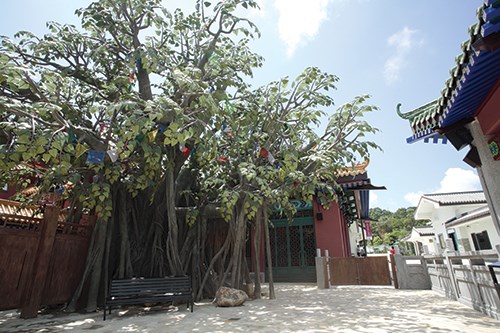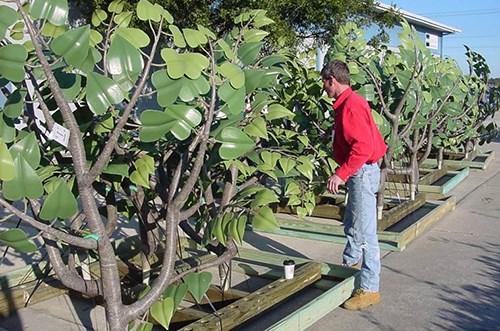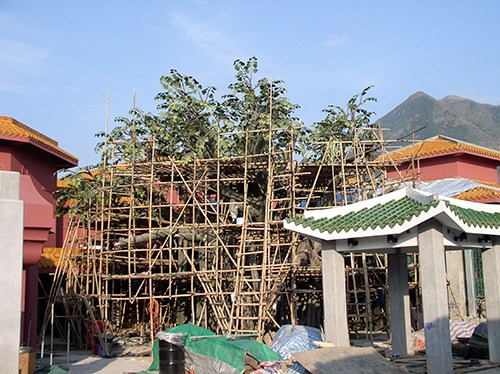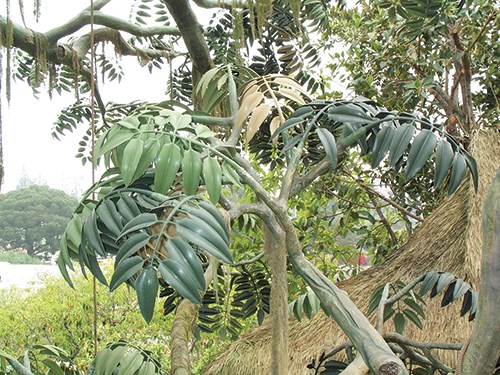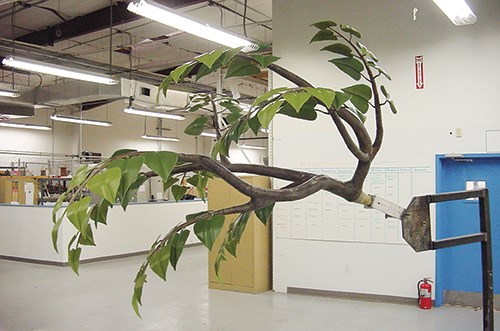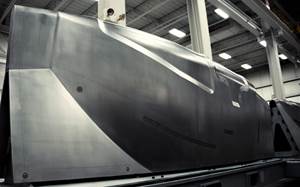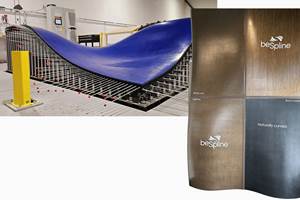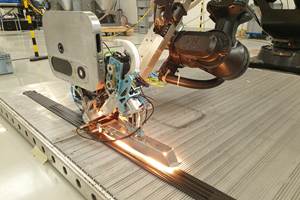Composites business does grow on trees
This advanced composites contractor welcomes down-to-earth opportunities to bring aerospace quality to fantasy foliage.
How does a full-service manufacturer of tight-tolerance, complex composite parts for the aerospace and defense industries find itself in a specialty niche, molding exotic artificial trees? Precisely because it is a manufacturer accustomed to aerospace challenges.
For Matrix Composites Inc. (Rockledge, Fla.), this obvious departure from its regular line of work isn’t as radical as it appears at first glance. In fact, when the company was approached by a major theme park in 1997 and asked to bid on its first tree-building project, the artificial tree in question was not what one might encounter indoors at a shopping mall. It was, instead, massive and a bit magical, and would be on display out of doors in all types of weather. Additionally, it had to meet fire codes and withstand live structural loading conditions that, given its Asian-Pacific location, could include hurricane-force winds. Designing and manufacturing the components of that tree ultimately required all the company’s expertise in building parts with demanding performance specifications. And although Matrix Composites had long traveled a carefully charted path, technically, its engineering crew soon discovered that everything else about what would be the first of several artificial-tree projects was new ground.
From right-brain to left-brain
“The first thing that strikes you about building these artificial tree branches,” says Dave Nesbitt, president and CEO of Matrix Composites, “is how the geometries are so complex.” Nesbitt notes that it was, at first, very difficult to conceive how to layup a tree branch in composites and make the result realistic. “The project required us to tap our creative, artistic side.”
The company has since designed and manufactured three other similar trees. The most recent, in 2009, was for the Ngong Ping 360 Exhibit on the north coast of Lantau Island in Hong Kong (pictured in the photos, here). The tree is part of the “Walking with Buddha” cultural exhibit, which visitors access via a 5.7-km/3.5-mile cable car ride into the hills above Ngong Ping village.
Matrix Composites’ customer on the project was MTR Corp. (Hong Kong, China), which built both the exhibit and the cable car system. The second and third trees, built respectively in 1999 and 2004, were projects for the original theme park customer, but each shipment was delivered to a different location.
The sizes, shapes and complex geometries of each tree, therefore, were unique. Overall tree design and dimensions in each case were specified by the customer’s drawings, which were supplied by architects and engineers who specialize in theme park and other artificial foliage construction. The customer also was responsible for hiring contractors to construct the tree’s main trunk, which is typically made with more conventional construction materials, such as steel and concrete. Nesbitt’s engineering team, then, was responsible for the rest of each tree, from the trunk up and out. Variations in the size and shape of each branch determined the structural loadings, which, in turn, influenced the quantity of structural material used in each branch. However, the basic manufacturing process, as described here, was similar for all the tree projects.
Making art practical
Because the number and complexity of unique, individual parts in a given tree proved daunting, the key to practical, cost-effective manufacturing was recognizing and building in some underlying simplicity. For the largest trees, therefore, Matrix Composites was able to develop nine to as few as six unique branch patterns. Engineers were able to recapture the complexity of a natural tree because those branches could be installed at any elevation and at any angle of rotation (360°) in relation to their points of attachment. “Even though we have a limited number of branch patterns, there is a nearly infinite amount of orientations that can occur with those patterns,” says Nesbitt, “so if you look at one of the trees, you may never recognize a repeating pattern.”
From the master drawings, then, Matrix Composites determined how many different branch patterns or sets it needed to build each tree, the elevation of each branch pattern within the tree and the angle of rotation relative to the main trunk and other branches adjacent to it. Within the specified spatial dimensions and appearance requirements, however, the Matrix team was solely responsible for individual branch design and construction.
Initial design of the individual branch components follows an iterative design/build/test process. “The geometries of the branches are so complex, it is somewhat difficult to perform an FEA analysis and be accurate because of the variations,” says Nesbitt. Instead, company engineers focused on a layup schedule that would get them close to the loading requirements, then they physically tested the branch structure in the laboratory, using load cells and extensometers to generate load and deflection data. If the prototype branch failed, the layup schedule and construction were modified until laminate load conditions were met, with appropriate safety margins. Then the design for that specific branch type was “locked down” in a CAD solid model and controlled using detailed process documentation.
In some cases, the loading requirements can be extreme, as Nesbitt explains: “A branch can be 4 or 5 ft [1.2 to 1.5m] tall, and if you can imagine placing it in a socket and hanging a 2,000 lb [907 kg] mass from it, that’s the kind of loads these parts can see in extreme typhoon conditions with 200-mph [161-kmh] winds.”
Artful manufacturing required
Each one of the unique branch patterns comprised one or two main branches (distinguished by being thicker than the other branches) and as many as 10 to 12 appendages or secondary branches. Then, there were sets of leaves attached to each of the side branches. The complexity of the geometry precluded the use of CNC machinery to cut patterns for individual branch sets. Instead, branch shapes were created by hand from Chavant clay, using the hand-lofting techniques automobile designers employ when creating a new car model. Master clay models were built for each branch and appendage. A release coat was applied to the masters, and room-temperature vulcanized (RTV) silicone molds were pulled directly from the models.
Next, the elastomeric molds were filled with a grade of Matrix Composites’ syntactic foam, and then were placed in a low-pressure compression press. The foam, which reportedly has the consistency of a “low-density playdough,” was catalyzed and then cured at room temperature in six to eight hours. The cured part was pulled from the mold, and then functioned as both the composite’s core and the mandrel on which technicians layed up the branch’s composite skin.
During layup, the syntactic core/mandrel was first overwrapped with a heat-curable film adhesive, then overlaid with multiple layers of glass-fiber braid supplied by A&P Technology (Cincinnati, Ohio). This was followed by unidirectional glass-fiber prepreg and additional film adhesive, both supplied by Ten Cate Advanced Composites (Nijverdal, The Netherlands). This sequence was repeated, as necessary, to build up the laminate to the required structural strength.
The finished layup was overwrapped with heat-activated shrink tape, supplied by Dunstone Co. Inc. (Charlotte, N.C.), then placed in an oven, and cured at 250°F/121°C for four to six hours. During cure, the shrink tape consolidated the laminate while the resin in the repeated layers of prepreg flowed, impregnating the interleaved braid.
After cure, the shrink tape was removed, and the process of attaching the secondary branches began. Although these were generally shorter and thinner than main branches, they also were constructed from a syntactic foam core/mandrel, using a similar layup, comprising TenCate’s film adhesive, A&P glass braid and prepreg, and a final overwrap of shrink tape. Then, the secondary branches were attached to the main branch with shrink tape, and the entire assembly was placed in an oven. Held in place by curing fixtures, the assembly is subjected to the same temperature for an additional four to six hours, to cure the laminates of the secondary branches and the joints where they intersected the main branch.
Although the main and secondary branch components were now unified structures, there was still much work to do. Finishing operations commenced with the removal of the shrink tape from the final branch assembly. Then, its entire outside surface was roughened via grit-blasting. After that, TC-4220 from BJB Enterprises (Tustin, Calif.), a thick epoxy texture coat, was applied to the composite with a trowel-like tool, using a variety of artistic techniques to create a continuous, bark-like texture on the branch surface. The coating cured at room temperature in several hours, after which several coats of a so-called “aging paint” called Duranar, from PPG Industries (Pittsburgh, Pa.), were applied to impart a natural, weathered look to the branch.
Finally, leaves injection molded by a subcontractor, using a fluropolymer resin made by Arkema (King of Prussia, Pa.), were inserted into the branch sockets, where they were both mechanically fastened and adhesively bonded. Here, differentiation of main and secondary branches through rotation created an additional challenge: The surfaces of their leaves had to point upward, toward the sun, as they would on a natural tree. For that reason, the elevation and orientation of each branch was specified in the drawings, and that information also was carried in a barcode and serial number printed on each branch. When an operator at Matrix Composites installed the leaves, he placed the branch in a fixture that positioned it in the same orientation it would have in the field.
Economies of scale
Given Matrix Composites’ high-tech core business, the growth of an off-shoot, specialty molding and fabrication business in outdoor artificial trees has come as a bit of surprise. “There’s not a huge demand for large, fake trees in the world,” Nesbitt quips, “so after we made our first one in 1997 we said, ‘Okay that was fun. Now let’s go back to our aerospace business.’ And we figured we’d never build another tree.” Yet, because Matrix Composites had demonstrated its capability to efficiently manufacture these unique, technically challenging structures, the same customer returned a second and third time, ordering trees larger and more complicated than their predecessors. Although the projects have come sporadically, each required a substantial quantity of individual subcomponents, representing significant business. Nesbitt reports, for example, that the company shipped as many as 60 transoceanic containers, total, in support of the two tree programs destined for installation near Hong Kong. One was for the most recent project, the Ngong Ping 360 Exhibit, and the other was for the theme park customer.
When the next artificial tree order will arrive is unknown, but if and when it does, it will be welcome, says Nesbitt. “It is a nice sidelight business,” he observes, “and it gives a bunch of geeky engineer-types a chance to step outside the high-tech world and do something a bit artistic.”
Related Content
Nine factors to consider when designing composites cure tooling
Gary Bond discusses the common pitfalls and compromises when designing good cure tooling and their holistic significance for a robust composite production process.
Read MorePlant tour: BeSpline/Addcomp, Sherbrooke, QC, Canada
Composites automation specialist increases access to next-gen technologies, including novel AFP systems and unique 3D parts using adaptive molds.
Read MoreATLAM combines composite tape laying, large-scale thermoplastic 3D printing in one printhead
CEAD, GKN Aerospace Deutschland and TU Munich enable additive manufacturing of large composite tools and parts with low CTE and high mechanical properties.
Read MoreImproving carbon fiber SMC simulation for aerospace parts
Simutence and Engenuity demonstrate a virtual process chain enabling evaluation of process-induced fiber orientations for improved structural simulation and failure load prediction of a composite wing rib.
Read MoreRead Next
VIDEO: High-volume processing for fiberglass components
Cannon Ergos, a company specializing in high-ton presses and equipment for composites fabrication and plastics processing, displayed automotive and industrial components at CAMX 2024.
Read MoreAll-recycled, needle-punched nonwoven CFRP slashes carbon footprint of Formula 2 seat
Dallara and Tenowo collaborate to produce a race-ready Formula 2 seat using recycled carbon fiber, reducing CO2 emissions by 97.5% compared to virgin materials.
Read More“Structured air” TPS safeguards composite structures
Powered by an 85% air/15% pure polyimide aerogel, Blueshift’s novel material system protects structures during transient thermal events from -200°C to beyond 2400°C for rockets, battery boxes and more.
Read More

